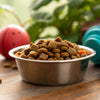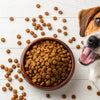Should Dogs Have Wet and Dry Food? Exploring the Best Feeding Options for Your Canine Companion
- Houndsy
Table of Contents
- Introduction
- Understanding Wet and Dry Dog Food
- Mixing Wet and Dry Dog Food: A Balanced Approach
- Special Considerations for Specific Dog Populations
- The Role of High-Quality Dog Food
- Incorporating the Houndsy Kibble Dispenser
- Conclusion
- FAQs
Introduction
Did you know that nearly 60% of dog owners are uncertain about the best diet for their pets? As dog parents, we often find ourselves standing in the pet food aisle, overwhelmed by the myriad choices available. One fundamental question arises: Should dogs have wet and dry food? This topic is essential not just for our furry friends’ palates but also for their health and well-being.
In this post, we will dive deep into the benefits and drawbacks of both wet and dry dog food, providing you with a comprehensive understanding of their nutritional values, textures, and how they can fit into your dog's daily feeding routine. By the end of this article, you will be equipped with the knowledge to make informed decisions about your dog’s diet, ensuring they receive the best possible nutrition while enjoying mealtime.
We will explore the different aspects of wet and dry foods, including processing methods, nutritional content, palatability, and practical feeding strategies. We'll also discuss how mixing wet and dry food can enhance your dog’s dining experience and support their health. So, let’s embark on this culinary adventure for our beloved pets, and perhaps consider how the Houndsy Kibble Dispenser can help streamline our feeding routines.
Understanding Wet and Dry Dog Food
What is Wet Dog Food?
Wet dog food, commonly referred to as canned food, is known for its high moisture content, usually ranging from 75% to 78%. This type of food is typically made by grinding protein sources (like meats), mixing in vitamins, minerals, and grains, and then cooking and sterilizing the mixture before canning it. The result is a flavorful, aromatic meal that many dogs find irresistible.
What is Dry Dog Food?
Dry dog food, or kibble, has a much lower moisture content, around 10%. The production process involves pulverizing meat and other ingredients into a dough, cooking it, shaping it into kibble, and then drying it. This method helps preserve the food longer, making it convenient for pet owners. Kibble can also be easier to store and manage, especially for those with busy lifestyles.
Nutritional Comparison
Both wet and dry dog food can provide balanced nutrition, but the major differences lie in their composition and benefits:
- Moisture Content: Wet food is hydrating, making it beneficial for dogs that don’t drink enough water. This can be especially vital for dogs with certain health conditions, such as urinary or kidney issues.
- Caloric Density: Dry food is usually more calorie-dense, which means dogs may consume fewer calories per serving compared to wet food. This can be useful for dogs that need to manage their weight.
- Palatability: Many dogs prefer the taste of wet food due to its aroma and texture, making it an excellent option for picky eaters or older dogs with diminished senses.
Pros and Cons of Wet Dog Food
Pros:
- Higher Moisture Content: Helps with hydration, particularly for dogs with urinary issues.
- Encourages Eating: The strong aroma can entice dogs with reduced appetites.
- Easier to Chew: Beneficial for dogs with dental problems or those recovering from surgery.
Cons:
- Cost: Generally more expensive than dry food on a per-serving basis.
- Spoilage: Once opened, wet food can spoil quickly if not consumed promptly.
- Dental Health: Does not provide the same chewing benefits as dry food, which can help with dental health.
Pros and Cons of Dry Dog Food
Pros:
- Cost-Effective: Usually less expensive and lasts longer than wet food.
- Convenience: Easy to measure and store; can be left out without spoilage.
- Dental Benefits: Chewing kibble can help reduce tartar buildup.
Cons:
- Lower Moisture: May not provide adequate hydration for some dogs.
- Palatability: Less flavorful than wet food, which might deter some picky eaters.
- Potential for Overeating: Dogs may consume more calories if not monitored due to its calorie density.
Mixing Wet and Dry Dog Food: A Balanced Approach
Many pet owners are now considering a mixed feeding approach, combining wet and dry dog food to leverage the benefits of both. This method can enhance the overall feeding experience for our furry friends.
Why Mix?
- Increased Palatability: Mixing wet food with dry can make meals more appealing, particularly for picky eaters.
- Hydration: Wet food increases moisture intake, which is beneficial for dogs that may not drink enough water.
- Variety: Just like us, dogs can get bored with their meals. Mixing different textures and flavors can create excitement around mealtime.
How to Mix Wet and Dry Food
When integrating both types of food, it’s essential to do so thoughtfully. Here are some tips to ensure your dog receives balanced nutrition:
- Consult Your Veterinarian: Always discuss dietary changes with your vet. They can help you calculate your dog's daily caloric needs and suggest appropriate proportions of wet and dry food.
- Monitor Caloric Intake: Keep track of the calories in both wet and dry food to avoid overfeeding. This is especially crucial if you're adding wet food to dry kibble.
- Adjust Gradually: If transitioning to a mixed diet, do it gradually over several days to avoid digestive upset. Start with small amounts of wet food mixed into the dry food, and increase over time as your dog adjusts.
Special Considerations for Specific Dog Populations
Picky Eaters
If your dog is a finicky eater, mixing wet and dry food can help. The enticing aroma of wet food may encourage them to finish their meals. Moreover, you can experiment with different brands and flavors to find what they love best.
Senior Dogs
Older dogs often face challenges like decreased appetite or dental issues. Wet food can be easier for them to chew and digest, while adding some dry food can help retain dental health benefits. A mixed diet can cater to their unique needs, ensuring they maintain a healthy weight and receive adequate hydration.
Dogs with Health Issues
Dogs with specific health concerns, such as kidney disease, may benefit from increased moisture in their diet. Conversely, dogs needing weight management might require controlled portions of calorie-dense dry food. Always seek guidance from your veterinarian to tailor a diet that aligns with your dog's health needs.
The Role of High-Quality Dog Food
When selecting wet or dry dog food, the quality of the ingredients matters. Here are some factors to consider:
- Ingredients: Look for high-quality protein sources, whole grains, and limited fillers. Avoid products with artificial additives or excessive preservatives.
- Nutritional Balance: Ensure the food meets the nutritional guidelines established by the Association of American Feed Control Officials (AAFCO).
- Brand Reputation: Choose brands that prioritize quality and have a good track record. Many pet owners recommend brands like Hill's Science Diet, Royal Canin, and Purina Pro Plan.
Incorporating the Houndsy Kibble Dispenser
At Houndsy, we understand the importance of making mealtime as enjoyable and stress-free as possible. Our flagship product, the Houndsy Kibble Dispenser, is designed with mid-century modern aesthetics and ergonomic convenience in mind. This innovative dispenser allows you to easily serve the perfect portion of dry kibble without bending, ensuring that your feeding routine is consistent and beautiful.
Not only does the Houndsy Kibble Dispenser hold 25-30 lbs of food, but it also features a BPA-free liner to keep kibble fresh and an auto-locking mechanism to prevent spills from curious paws or tiny hands. By integrating the Houndsy Kibble Dispenser into your routine, you can simplify your feeding process, allowing you to focus on what truly matters: enjoying quality time with your furry friend.
Explore our Houndsy Kibble Dispenser here and elevate your dog-feeding experience.
Conclusion
In summary, the question of whether dogs should have wet and dry food is not merely about preference; it’s about understanding our dogs' nutritional needs and providing them with a balanced diet. Both wet and dry foods offer unique benefits, and mixing them can create a more enjoyable and healthful feeding experience.
As responsible pet parents, we must be attentive to our dogs' dietary requirements and open to experimenting with different feeding combinations. Whether you opt for wet food, dry kibble, or a mix of both, the goal remains the same: to nourish our furry companions in a way that supports their health, happiness, and overall quality of life.
Reflecting on our feeding routines, we encourage you to evaluate what works best for your dog. After all, mealtime should be a joyful and enriching experience. If you're ready to take your dog’s feeding game to the next level, consider enhancing your routine with the Houndsy Kibble Dispenser.
FAQs
Can I feed my dog only wet food?
Yes, dogs can thrive on a diet of only wet food, as it can provide complete nutrition. However, ensure it meets AAFCO guidelines.
Is it safe to mix wet and dry dog food?
Absolutely! Mixing wet and dry food is safe and can enhance palatability and hydration.
How do I determine the right portion sizes for my dog?
Consult your veterinarian to calculate your dog's daily caloric needs based on their breed, size, age, and activity level.
Can I leave dry food out for my dog all day?
Yes, dry food can be left out safely without spoiling. However, monitor the portion to prevent overeating.
What signs should I look for to determine if my dog prefers wet or dry food?
Picky eaters may show reluctance to eat dry kibble but eagerly consume wet food. Observe your dog's eating habits to make an informed choice.
For a more enjoyable feeding experience, remember to check out the Houndsy Kibble Dispenser here.












